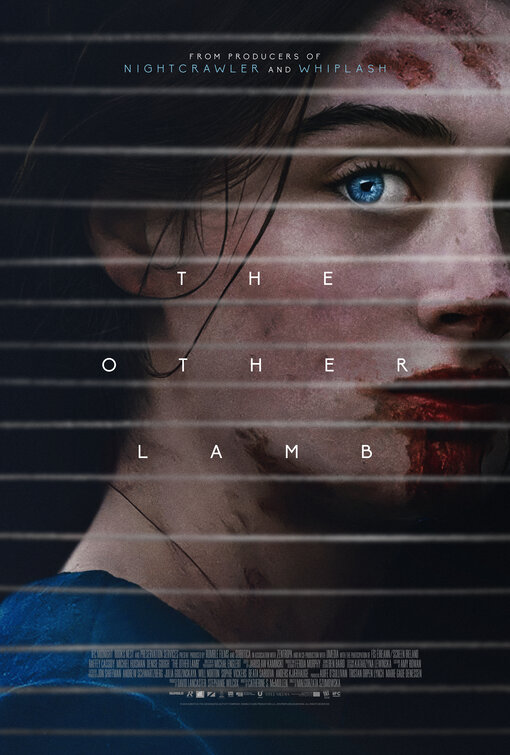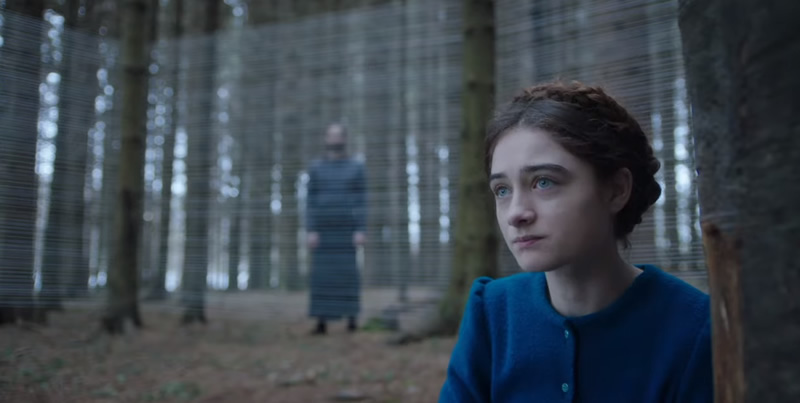by Chris Feil
 Fueled by a fevered intensity, Małgorzata Szumowska's The Other Lamb follows the stoic Selah (Raffey Cassidy) as she comes of age in a cult hidden within the American mountainside. Her fellow believers are all women, suggestively separated by uniforms of blue and red, and under the charms of the faux-Jesus man they refer to only as Shepherd (Michiel Huisman). Selah was born into the flock without experience of the outside world or any of its modernity, instead knowing a normalcy of blood ritual and ominous polygamy.
Fueled by a fevered intensity, Małgorzata Szumowska's The Other Lamb follows the stoic Selah (Raffey Cassidy) as she comes of age in a cult hidden within the American mountainside. Her fellow believers are all women, suggestively separated by uniforms of blue and red, and under the charms of the faux-Jesus man they refer to only as Shepherd (Michiel Huisman). Selah was born into the flock without experience of the outside world or any of its modernity, instead knowing a normalcy of blood ritual and ominous polygamy.
But as the arrival of puberty brings the threat of becoming one of the Shepherd’s many wives, Selah experiences visions that enlighten her to the sinister nature that belies her deceptively peaceful existence, setting into motion her rebellion...
If the film promises something lurid on the surface, it meets those expectations with deeper emphasis on developing its underlying themes than attempting to shock. Without many concrete indications to period (and even the signals of an American setting are obscured), The Other Lamb has a displacement in time that replicates the timelessness of patriarchal influence without feeling on the nose. After a visit from the local police sends Shepherd and his followers on an odyssey for safer terrain, the literal quest for a home mirrors Selah’s internal journey to find her voice. Szumowska strikes a deft balance here that isn’t as thematically obvious as it sounds, but finding emotional and psychological textures in the film’s sensory experience. The Other Lamb stews in flames, blows in damp wind, and grasps in claws into cursed earth.
The film straddles the line between psychological horror and topical character study that has also been traversed this year in films like Swallow and The Invisible Man. By comparison, The Other Lamb is more temporal in its examination of female subjugation and, somewhat boldly, without simplified answers at its conclusion. Despite not bringing much new to a familiar concept, Szumowska’s enigmatic and expansive visual approach gives the film a distinct psychological depth. At a brisk 97 minutes, she gets at the deep psychological roots of male domination and renders something as alarming as that should be.

Cassidy however is quickly becoming a mainstay to stark auteur darkness, with this film joining Vox Lux and The Killing of a Sacred Deer for her bleak trilogy of shattered conformity. This most directly approaches the expectations of women in toxic societies among them and allows the actress to give her most arresting performance yet. Cassidy conveys a tidal wave behind her eyes, charting Selah’s internal dismantling with mounting, wary rage that’s all physical nuance. She’s as captivating as the film’s primal imagery, but lends a necessary humanity to the soulful horror at play in the film.
With a disarming Denise Gough (of the recent Angels in America revival) as the cult’s ostracized rebellious elder, The Other Lamb takes larger societal issues and wrings them for all that is personal and internalized. Szumowska pairs the beautiful and the brutal alongside one another to embody the toxicity of male oppression that still manages a persuasive sway. It may be a more modest narrative success, but it’s a complete one in terms of placing us in a feeling.
Grade: B
The Other Lamb is available on VOD today!